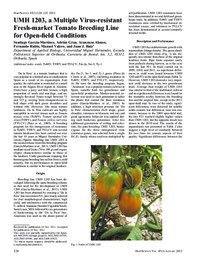Por favor, use este identificador para citar o enlazar este ítem:
https://hdl.handle.net/11000/34467Registro completo de metadatos
| Campo DC | Valor | Lengua/Idioma |
|---|---|---|
| dc.contributor.author | García Martínez, Santiago | - |
| dc.contributor.author | Grau Sánchez, Adrián | - |
| dc.contributor.author | Alonso Sanchis, Aránzazu | - |
| dc.contributor.author | Rubio López, Fernando | - |
| dc.contributor.author | Valero Roche, Manuel | - |
| dc.contributor.author | Ruiz Martínez, Juan José | - |
| dc.contributor.other | Departamentos de la UMH::Biología Aplicada | es_ES |
| dc.date.accessioned | 2025-01-15T09:25:43Z | - |
| dc.date.available | 2025-01-15T09:25:43Z | - |
| dc.date.created | 2012-01 | - |
| dc.identifier.citation | HortScience 47(1):124–125. 2012 | es_ES |
| dc.identifier.issn | 0018-5345 | - |
| dc.identifier.issn | 2327-9834 | - |
| dc.identifier.uri | https://hdl.handle.net/11000/34467 | - |
| dc.description.abstract | ‘De la Pera’ is a tomato landrace that is very popular in a limited area in southeastern Spain as a result of its organoleptic fruit quality. Its cultivation is restricted to a small area in the Segura River region in Alicante. Fruits have a juicy and firm texture, a high proportion of seeds and mucilage, and are strongly flavored. Fruits weigh between 75 and 125 g, varying from elongated-oval to bell shape with dark green shoulders and without ribs. However, like most tomato landraces, De la Pera cultivars are highly susceptible to several viruses such as Tomato mosaic virus (ToMV), Tomato spotted wilt virus (TSWV), and Tomato yellow curl virus (TYLCV) (Ruiz et al., 2005). A breeding program for the introgression of resistance to ToMV, TSWV, and TYLCV into several tomato landraces has been carried out over the last 10 years at Miguel Hernández University (Spain). Breeding line UMH 1203 is the second release from this breeding program (García-Martínez et al., 2011). UMH 1203 has medium-sized fruits (70 to 100 g) and organoleptic characteristics similar to those of the landrace. Under greenhouse cropping, this homozygous breeding line suffers from a yield penalty, but its performance in open-field conditions is similar to the original landrace | es_ES |
| dc.format | application/pdf | es_ES |
| dc.format.extent | 2 | es_ES |
| dc.language.iso | eng | es_ES |
| dc.publisher | American Society for Horticultural Science | es_ES |
| dc.rights | info:eu-repo/semantics/openAccess | es_ES |
| dc.rights | Attribution-NonCommercial-NoDerivatives 4.0 Internacional | * |
| dc.rights.uri | http://creativecommons.org/licenses/by-nc-nd/4.0/ | * |
| dc.subject | ToMV | es_ES |
| dc.subject | TSWV and TYLCV | es_ES |
| dc.subject | Tm-2a | es_ES |
| dc.subject | Sw-5 | es_ES |
| dc.subject | Ty-1 | es_ES |
| dc.title | UMH 1203, a Multiple Virus-resistant Fresh-market Tomato Breeding Line for Open-field Conditions | es_ES |
| dc.type | info:eu-repo/semantics/article | es_ES |
| dc.relation.publisherversion | https://doi.org/10.21273/HORTSCI.47.1.124 | es_ES |

Ver/Abrir:
HortScience-UMH1203, a multiple virus-resistant fresh-market tomato breeding line for open-field conditions.pdf
929,42 kB
Adobe PDF
Compartir:
 La licencia se describe como: Atribución-NonComercial-NoDerivada 4.0 Internacional.
La licencia se describe como: Atribución-NonComercial-NoDerivada 4.0 Internacional.
.png)